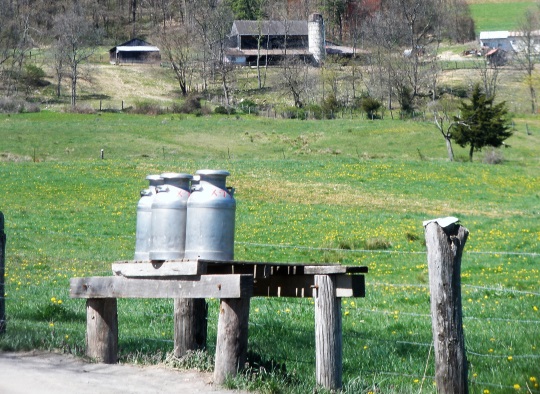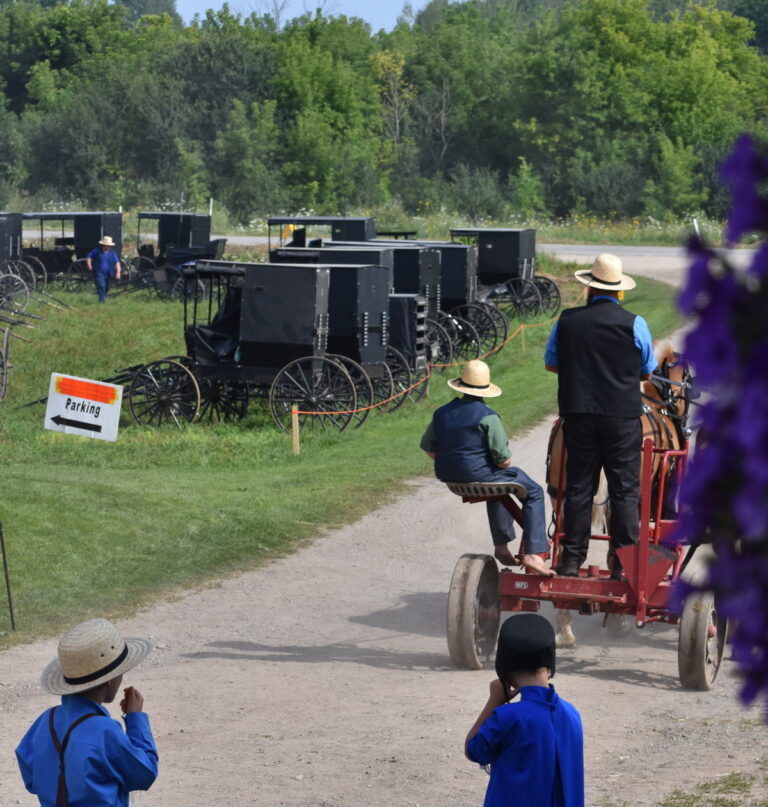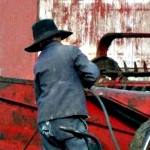Visiting The Amish of Big Valley – Part 2: Milk Cans & Farm Runoff
After Tuesday’s visit to the Belleville auction and market, Jerry continues with a look at two aspects of farming among Amish in Big Valley.
Below you’ll find more on one old-fashioned technology still in use in this community, and on an environmental challenge involving Amish farmers.
Thanks to Jerry’s report, I learned more than I thought there was to know about the cans some Amish use to collect and move their milk. Here’s Jerry with more.
After visiting the Belleville Market it was time to drive out into the country.
I saw many farmers using horse teams plowing fields in prep for this year’s crops.

Milk Cans
Milk cans out by the road waiting for pick up by the milk processors. Transporting raw milk in milk cans is outdated technology. The Amish are probably the only ones (or among the very few) doing it nowadays.

The farmer has to have two sets of cans. Each can is numbered with the farmer’s exclusive number. The milk is picked up two or three times a week.

When the driver picks up the cans, he drops off the cans he picked up last time. These returned empty cans have been sanitized before returning and are chemically sanitized again before the farmer refills them.
Some but few cans are made from stainless steel. Most are galvanized steel. When cans get banged around they can lose their finish.

I actually found an Amish business that restores milk cans. He cleans the cans, removes dents, sometimes welds (gas) repairs and then dips each can into a hot tin solution. He only performs this operation two or three times a year.
Many farmers use gasoline engine air compressors to power their milking machines and keep the milk cans in coolers LPG power sourced. Some farms have large diesel engines that provide generated electricity.

Farm Runoff
Environmentalists have determined that animal waste draining into the watershed is harming the Chesapeake Bay. I’ve heard speakers, and read that cows free-range grazing in fields with small “branches” running through them, are the biggest contributor.

They also target Amish as the biggest cause. In many English farms in the lower basin, many small streams are being fenced off and planted with native trees to curb the problem. The fencing is almost always subsidized by Federal and State monies.

The experts are pointing to the Amish for their unwillingness to participate in the fencing.
The farmers do not wish to lose the grazing land, the source of animal drinking water, and they object to the government giving them funding.
Often pastures with a “branch” running through provides the best grazing in hot dry summers, and tend to be the last grass in the fall and the first in the spring.
Up next: Schools, Scooters and Stores







Amish Not the Problem
I work in the environmental field and am familiar with EPA requirements concerning nutrient concentration in run-off from farm fields. One way to fight run-off is through grass and tree buffer zones around small streams and drainage ditches. In our area, when the government began to subsidize ethanol production, the per bushel price of corn skyrocketed. Farmers began to plow up what had been pasture to plant corn. They also bull-dozed the buffer zones around streams and ditches just to get more planting area. All these things caused more run-off. Another example of unintended consequences.
I wrote the EPA RULES AND REGULATOINS TITLE 40 1976
Regarding the EPA Clean Water Regulations of the Clean Water Act written many decades ago. The Secret to compliance is small farms of approximately 20 acres or less controlling the number of animals per acre which should be no more than the soil can absorb. COMMON SENSE. IF YOU are SEEING GREEN SLIM IN YOU PONDS THEN MOST LIKE THE RUNOFF THE POND is TOO HIGH IN NUTRIENTS. RECYCLE REUSE EVERYTHING. SELL THE RECYCLABLES FOR CASH. DO NOT DRINK SMOKE OR TATOO YOURSELF. AND most common colds are caused from Bacteria in the water which grow on the slim.
And Please do not try to build a toilet for a Clydesdale or An African Elephant AND Have a Great Weekend.
Rob Pappenfort
Southwest Iowa
Year of our Lord
May 6, 2016
I’m not really qualified to comment on the runoff issue, but the last line here makes a lot of sense to me 🙂
Large Mammal Sanitary Facilities
Erik, the actual toilet construction is comparatively simple. It’s the “potty training” that poses the bigger problem.
Unintended consequences...
PYDOG, I hope someone from the “government” becomes a regular reader of this blog. They may learn a thing or two.
Alice Mary
Family Farms
The ways of the Amish Farming are as old as the bible. Animals waste can be a problem but only if the land is overloaded. Runoff from a smaller farm is easier to control. Giant commercial feedlots of commercial non Amish farms and WALMART PARKING LOTS and CLUSTERS OF CONCRETE BLOBS OF VERY POORLY CONSTRUCTED TOWNS EXAMPLE: EAST BLOOMFIELD,IOWA. AND BRANSON,MISSOURI.
I have environmental records back to 1940 when lithium was first added to the periodic table. Lithium BATTERIES POLLUTE MORE THAT ALL THE AMISH IN THE WORLD. Having worked EPA ENFORCEMENT 46 years it is not an easy job. EXCEPT FOR THE CURRENT WASHINGTON REALLY EDUCATED CZAR PEOPLE.These are some of the TOXIC METALS: LITHIUM LEAD BARIUM ARSENIC CHROME 6 NICKEL ZINC Cadmium BORON Phosphorus.
Our enemy is technology devices TOXIC METALS. EVEN THIS DEVICE I TYPE ON POLLUTES MORE THAN ANY ANIMAL.
Radioactive wastes are even trickier to evaluate and dispose.
COMMON HORSE SENSE! In Enforcement of any LAW WORKS. STUPID LAWS DONT WORK. RECYCLE REUSE and Reclaim the land. WASTE IS THAT FOR WHICH THERE IS NO USE INTENDED. AND PRAY. And Don’t save the Fire ANT AS THEY SAY IN TEXAS we have a good supply.
My Great Aunt Hazel McCallister Smith of Louisiana,Mo. always said as she baked: YOU CANNOT TAKE IT WITH YOU WHEN YOU GO UP ON THE HILL meaning the Riverview Cemetery.
You will find the highest levels of Lithium in DEATH VALLEY AND IN VOLCANIC AREAS. And TRY TO distribute the Farm Equipment in North Missouri to other Areas in need. Thank you.
Robert W. Pappenfort,P.E.
Pappenfort Oil Company, Inc.
Exploration and Production
Illinois, Iowa and Kansas
Since 1848.